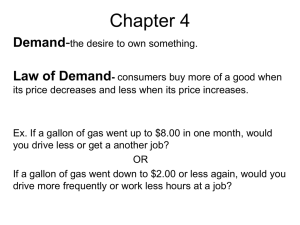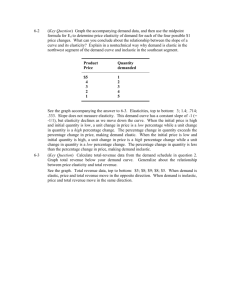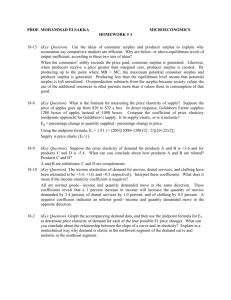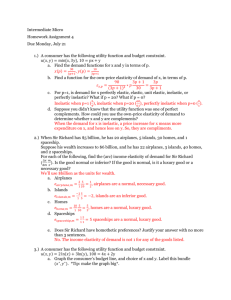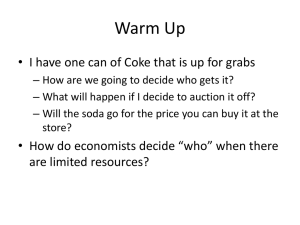Principles of Microeconomics, 7e (Case/Fair)
advertisement
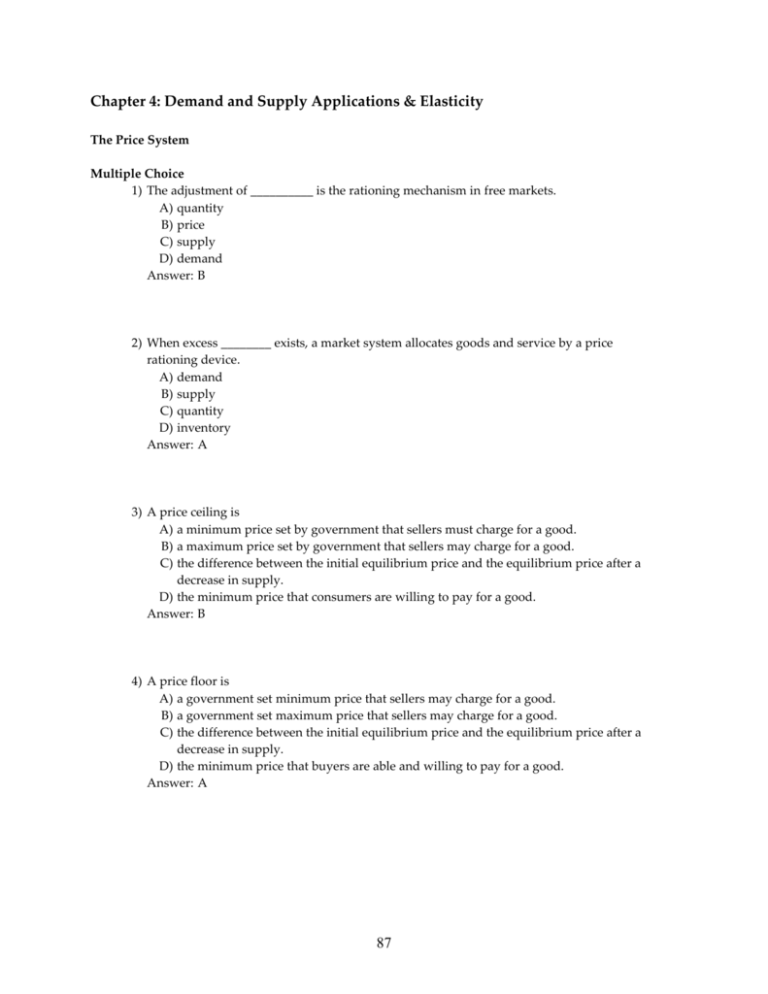
Chapter 4: Demand and Supply Applications & Elasticity The Price System Multiple Choice 1) The adjustment of __________ is the rationing mechanism in free markets. A) quantity B) price C) supply D) demand Answer: B 2) When excess ________ exists, a market system allocates goods and service by a price rationing device. A) demand B) supply C) quantity D) inventory Answer: A 3) A price ceiling is A) a minimum price set by government that sellers must charge for a good. B) a maximum price set by government that sellers may charge for a good. C) the difference between the initial equilibrium price and the equilibrium price after a decrease in supply. D) the minimum price that consumers are willing to pay for a good. Answer: B 4) A price floor is A) a government set minimum price that sellers may charge for a good. B) a government set maximum price that sellers may charge for a good. C) the difference between the initial equilibrium price and the equilibrium price after a decrease in supply. D) the minimum price that buyers are able and willing to pay for a good. Answer: A 87 5) A maximum price, set by the government, that sellers may charge for a good is known as a A) price floor. B) price rationing mechanism. C) price ceiling. D) subsidy. Answer: C 6) A minimum price, set by the government, that sellers may charge for a good is known as A) a price floor. B) a price rationing mechanism. C) a price ceiling. D) a subsidy. Answer: A 7) For a price ceiling to cause a shortage in a market, the government must set it _______ the equilibrium market price. A) above B) at C) below D) sometimes above and sometimes below Answer: C 8) Assume the market equilibrium price of rice is $5.00 per pound. If the government does not allow rice farmers to charge more than $1.00 per pound of rice, A) there will be a rice surplus. B) there will be a rice shortage. C) quantity demanded will equal quantity supplied. D) the market equilibrium price will move from $5.00 to $1.00. Answer: B 9) If a(n) _________ some alternate rationing device will become necessary. A) ceiling price falls short of the equilibrium price B) excess quantity supplied exists C) surplus exists D) price floor is set below the equilibrium price Answer: A 88 Refer to the information provided in Figure 4.1 below to answer the questions that follow. Figure 4.1 10) Refer to Figure 4.1 An example of an effective price ceiling would be the government setting rental rates for apartments at A) $400. B) $500. C) $600. D) $700. Answer: A 11) Refer to Figure 4.1 An example of an effective price floor would be the government setting rental rates for apartments at A) below $400. B) $400. C) $500. D) $600. Answer: D 12) Refer to Figure 4.1. If the government will not allow landlords to charge more than $400 for an apartment, which of the following will happen? A) Demand must eventually decrease so that the market will come into equilibrium at a price of $400. B) Supply must eventually increase so that the market will come into equilibrium at a price of $400. C) A nonprice rationing system such as queuing must be used to ration the available supply of apartments. D) The market will be in equilibrium at a price of $400. Answer: C 89 13) Refer to Figure 4.1 If the government will not allow landlords to charge less than $600 for an apartment, which of the following will happen? A) Demand must eventually increase so that the market will come into equilibrium at a price of $600. B) Supply must eventually decrease so that the market will come into equilibrium at a price of $600. C) Landlords will supply more apartments than renters will demand. D) The market will be in equilibrium at a price of $600. Answer: C 14) If government sets a price ceiling below an equilibrium price, A) quantity demanded will equal quantity supplied. B) there will be a surplus. C) there will be a shortage. D) demand will be less than supply. Answer: C 15) If government sets a price floor below an equilibrium price, A) quantity demanded will equal quantity supplied. B) there will be a surplus. C) there will be a shortage. D) the floor will be ineffective. Answer: D 16) If government sets a price ceiling above an equilibrium price, A) the ceiling will be ineffective. B) there will be a surplus. C) there will be a shortage. D) demand will be less than supply. Answer: A 17) If government sets a price floor above the equilibrium price, A) quantity demanded will equal quantity supplied. B) there will be a surplus. C) there will be a shortage. D) demand will be less than supply. Answer: B 90 18) The government imposes a maximum rental price on apartments that is ABOVE the equilibrium rental price. You accurately predict that A) the law will be ineffective and have no economic impact. B) the law will be effective and create a surplus of apartments. C) renters will find that landlords start offering to furnish the apartments. D) landlords are less likely to do routine maintenance work in the apartments. Answer: A 19) The government imposes a price ceiling on gasoline that is BELOW the market equilibrium price. You are asked to suggest a rationing scheme that will minimize the misallocation of resources. You suggest using rationing A) coupons that can be resold. B) coupons that cannot be resold. C) on a first-come, first-served basis. D) only on weekdays. Answer: A 20) Assume the government imposes a price ceiling on sugar that is ABOVE the market equilibrium price. You are asked to suggest a rationing scheme that will minimize the misallocation of resources. You suggest A) using rationing coupons that cannot be resold. B) using rationing on a first-come, first-served basis. C) using rationing coupons that can be resold. D) that no rationing system will be necessary. Answer: D 21) If the government imposes a maximum price that is above the market equilibrium price, the A) ceiling price will have no economic impact and price will return to equilibrium. B) ceiling price will have an economic impact and price will not return to equilibrium. C) government will create a permanent surplus of the commodity. D) available supply must be rationed with a nonprice rationing mechanism. Answer: A 22) People scalping tickets for a rock concert can sell their tickets for a profit A) any time the rock group is popular. B) when the price set by the concert hall is less than the market equilibrium price. C) when prices are too high. D) only when there is excess supply. Answer: B 91 23) People most successfully scalp tickets for a rock concert when the A) quantity of tickets available exceeds the quantity demanded. B) price set by the concert hall is less than the market equilibrium price. C) price set by the concert hall exceeds the market equilibrium price. D) price set by the concert hall equals the market equilibrium price. Answer: B 24) People scalping tickets for the Super Bowl will be successful A) any time the Super Bowl is popular. B) when prices are too high. C) when the price set by the National Football League is less than the market equilibrium price. D) only when there is excess supply. Answer: C 25) If the equilibrium price of gasoline is $2.00 per gallon and the government will not allow oil companies to charge more than $1.00 per gallon of gasoline, which of the following will happen? A) Demand must eventually decrease so that the market will come into equilibrium at a price of $1.00. B) Supply must eventually increase so that the market will come into equilibrium at a price of $1.00. C) A nonprice rationing system such as ration coupons must be used to ration the available supply of gasoline. D) The market will be in equilibrium at a price of $1.00. Answer: C 26) An example of an ineffective price ceiling would be the government setting the price of gasoline at __________ per gallon when the market price is at $2.00 per gallon. A) $1.25 B) $1.50 C) $1.75 D) $2.25 Answer: D 92 27) Consider a market that has many buyers but only one seller. Assume the seller has only one unit of the product to sell. Then the market demand curve will be ________ and the seller’s supply curve will be _______. A) horizontal; horizontal B) vertical; upward sloping C) downward sloping; vertical D) downward sloping; upward sloping Answer: C 28) In the former Soviet Union, central planners fixed the quantity supplied of a staple product in a market at a certain level regardless of the price. The planners also would set the market price below what the equilibrium price would have been. Soviet citizens ________in line to buy staple products and _______ the amount they wanted to buy given the price they paid. A) stood; received B) stood; did not receive C) did not stand; received D) did not stand; did not receive Answer: B Supply and Demand Analysis Multiple Choice Refer to the information provided in Figure 4.2 below to answer the questions that follow. Figure 4.2 93 1) Refer to Figure 4.2. At the world price of $10 per barrel of oil, the United States imports __________ million barrels of oil per day. A) 3 B) 5 C) 8 D) 11 Answer: B 2) Refer to Figure 4.2. If a $2 per barrel tax is levied on imported oil, the United States will _______ million barrels of oil per day. A) import 2 B) import 5. C) import 8 D) export 8 Answer: A 3) Refer to Figure 4.2. If the United States levies no taxes on imported oil, the price of oil in the United States A) would be $8 per barrel, and the United States would import 8 million barrels of oil per day. B) would be $10 per barrel, and the United States would import 5 million barrels of oil per day. C) would be $12 per barrel, and the United States would import 2 million barrels of oil per day. D) after the U.S. government eliminated all taxes on imported oil cannot be determined from this information. Answer: B 4) Refer to Figure 4.2. Assume that initially there is free trade. If the United States then imposes a $2 tax per barrel of imported oil, A) the quantity demanded of oil will be reduced by 2 million barrels per day. B) the quantity of oil supplied by U.S. firms will increase by 5 million barrels per day. C) U.S. imports of oil will increase by 3 million barrels per day. D) the price of oil in the U.S. will increase to $12 per barrel. Answer: D 94 5) Refer to Figure 4.2. Assume that initially there is free trade. If the United States then imposes a $2 tax per barrel of imported oil, the tax revenue generated will equal _______ million per day. A) $4 B) $6 C) $10 D) $14 Answer: A Refer to the information provided in Figure 4.3 below to answer the questions that follow. Figure 4.3 6) Refer to Figure 4.3. At the world price of 50 cents per bell pepper the United States imports __________ million bell peppers per day. A) 1 B) 2 C) 3 D) 4 Answer: C 7) Refer to Figure 4.3. If a 10-cent-per-bell-pepper tax is levied on imported bell peppers, the United States will import _____ million bell peppers per day. A) 4 B) 3 C) 2 D) 1 Answer: D 95 8) Refer to Figure 4.3. If the United States levies no taxes on bell peppers, the price of bell peppers in the United States A) would be 40 cents per bell pepper, and the United States would import 5 million bell peppers per day. B) would be 60 cents per bell pepper, and the United States would import 1 million bell peppers per day. C) would be 50 cents per bell pepper, and the United States would import 3 million bell peppers per day. D) after the U.S. government eliminated all taxes on imported bell peppers cannot be determined from this information. Answer: C 9) Refer to Figure 4.3. Assume that initially there is free trade. If the United States then imposes a 10-cent tax per bell pepper, A) the quantity demanded of bell peppers will be reduced by 2 million bell peppers per day. B) the quantity of bell peppers supplied by U.S. firms will increase by 5 million bell peppers per day. C) the price of bell peppers in the United States will increase to 60 cents per bell pepper. D) U.S. imports of bell peppers will increase by 3 million per day. Answer: C Refer to the information provided in Figure 4.4 below to answer the questions that follow. Figure 4.4 96 10) Refer to Figure 4.4. At the world price of $20 per computer chip, the United States imports __________ million computer chips. A) 2 B) 6 C) 10 D) 12 Answer: B 11) Refer to Figure 4.4. If a $5.00 each computer chip tax is levied on imported computer chips, the United States will import _____ million computer chips. A) 6 B) 10 C) 4 D) 2 Answer: D 12) Refer to Figure 4.4. If the United States eliminates all taxes on computer chips, the price of computer chips in the United States A) would be $15 per computer chip, and the United States would import 10 million computer chips. B) would be $25 per computer chip, and the United States would import 2 million computer chips. C) would be $20 per computer chip, and the United States would import 6 million computer chips. D) cannot be determined from this information. Answer: C 13) Refer to Figure 4.4. Assume that initially there is free trade. If the United States then imposes a $5.00 tax on imported computer chips, A) the quantity demanded of computer chips will be reduced by 4 million computer chips. B) the quantity of computer chips supplied by U.S. firms will increase by 2 million computer chips. C) the price of computer chips in the United States will decrease to $15. D) U.S. imports of computer chips will increase by 1 million computer chips. Answer: B 97 14) Refer to Figure 4.4. Assume that initially there is free trade. If the United States then imposes a $5.00 per computer chip tax on imported computer chips, the tax revenue generated will equal ______ million. A) $50 B) $10 C) $60 D) $75 Answer: B Supply and Demand and Market Efficiency Multiple Choice 1) The difference between the maximum amount a person is willing to pay for a good and its current market price is known as A) producer surplus. B) profits. C) revealed preferences. D) consumer surplus. Answer: D 2) The difference between the minimum amount a firm is willing to accept for a good and its current market price is known as A) the paradox of value. B) profits. C) producer surplus. D) consumer surplus. Answer: C 3) You would be willing to pay a maximum of $50 to attend a concert, and you can buy a ticket for $30. Your consumer surplus is A) $10. B) $20. C) $30. D) $50. Answer: B 98 4) You would be willing to pay a maximum of $100 to attend a football game, and you can buy a ticket for $30. Your consumer surplus is A) $30. B) $50. C) $70. D) $100. Answer: C 5) When the equilibrium price of ginger ale increases while your demand schedule for ginger ale remains unchanged, then your consumer surplus A) decreases. B) increases. C) remains constant. D) may increase or decrease depending on the amount of the price decrease. Answer: A 6) When buyer and seller trade to the market equilibrium quantity, they A) maximize the difference between consumer and producer surplus. B) minimize the sum of consumer and producer surplus. C) minimize deadweight loss. D) maximize deadweight loss. Answer: C Refer to the information provided in Figure 4.5 below to answer the questions that follow. Figure 4.5 99 7) Refer to Figure 4.5. Which of the following areas represents consumer surplus? A) A B) B C) C D) E Answer: A 8) Refer to Figure 4.5. Which of the following areas represents producer surplus? A) A B) B C) C D) E Answer: B 9) Refer to Figure 4.5. Which of the following areas represents deadweight loss? A) A B) B C) C D) There is no deadweight loss in this market. Answer: D 10) There will be a deadweight loss in a market if A) the actual quantity traded equals the market equilibrium quantity. B) the actual quantity traded is other than the market equilibrium quantity. C) producer surplus exceeds consumer surplus. D) consumer surplus exceeds producer surplus. Answer: B 11) When there is a deadweight loss because of _________ in a market, the full cost of production _______ consumer willingness to pay. A) underproduction; rises above B) overproduction; rises above C) underproduction; equals D) overproduction; falls below Answer: D 100 12) When the government sets a price floor above the equilibrium price in a market, consumer surplus will A) rise. B) fall. C) not change. D) not enough information available to determine an answer. Answer: B 13) Suppose market demand and supply curves are linear and the market price settles to the equilibrium level. We can calculate the cumulative consumer surplus as the area of a ______. A) circle B) square C) rectangle D) triangle Answer: D True/False 1) Deadweight loss is minimized when the market achieves the equilibrium price. Answer: TRUE 101 Elasticity Multiple Choice Refer to the information provided in Figure 5.1 below to answer the questions that follow. Figure 5.1 1) Refer to Figure 5.1. The demand for tickets is A) perfectly elastic. B) perfectly inelastic. C) unitarily elastic. D) income elastic. Answer: B 2) Price is determined entirely by demand when A) demand is downward sloping. B) demand is perfectly inelastic. C) supply is perfectly inelastic. D) supply is perfectly elastic. Answer: C 3) When supply is perfectly inelastic, A) price is determined solely by supply. B) price is determined solely by demand. C) only the government can set the price. D) the price may be set by either supply or demand. Answer: B 102 4) A ________ line is a perfectly price elastic demand curve. A) horizontal B) vertical C) positively sloped D) negatively sloped Answer: A 5) A ________ line is a perfectly price inelastic demand curve. A) horizontal B) vertical C) positively sloped D) negatively sloped Answer: B 6) When the price of radios increases 5%, quantity demanded decreases 5%. The price elasticity of demand for radios is A) perfectly inelastic. B) elastic. C) inelastic. D) unitary elastic. Answer: D 7) When the price of fresh fish increases 5%, quantity demanded decreases 10%. The price elasticity of demand for fresh fish is A) perfectly inelastic. B) elastic. C) inelastic. D) unitary elastic. Answer: B 8) When the price of coffee increases 5%, quantity demanded decreases 3%. The elasticity for coffee is A) perfectly price inelastic. B) price elastic. C) price inelastic. D) price unitary. Answer: C 103 9) The ABC Computer Company wants to increase the quantity of computers it sells by 5%. If the price elasticity of demand is -2.5, the company must ________ price by _______. A) increase; 2.0% B) decrease; 2.0% C) increase; 0.5% D) decrease; 0.5% Answer: B 10) The government wants to reduce the consumption of electricity by 5%. The price elasticity of demand for electricity is 4. The government should _______ the price of electricity by ______. A) raise; 2.0% B) raise; 0.08% C) raise; 1.25% D) lower; 0.4% Answer: C 11) The government wants to reduce the consumption of electricity by 10%. The price elasticity of demand for electricity is -.4. The government should ________ the price of electricity by _____. A) raise; 2.0% B) raise; 25.0% C) raise; 0.04% D) lower; 0.4% Answer: B 12) The price elasticity of demand for bottled water in Texas is -2, and the price elasticity of demand for bottled water in Missouri is -0.8. In other words, demand in Texas is __________ and demand in Missouri is __________. A) elastic; inelastic B) inelastic; elastic C) elastic; unitarily elastic D) inelastic; unitarily inelastic Answer: A 104 13) An increase in supply caused no change in equilibrium quantity bought and sold. Thus, demand must be A) perfectly inelastic. B) inelastic. C) elastic. D) unitarily elastic. Answer: A 14) If the demand for oranges is unitarily elastic, the price elasticity of demand for oranges is A) 0.0. B) 1.0. C) -1.0. D) -100.0. Answer: C Refer to the information provided in Figure 5.2 below to answer the questions that follow. Figure 5.2 15) Refer to Figure 5.2. Using the midpoint formula, if the price of a hamburger is increased from $8 to $10, the price elasticity of demand equals A) 0.36. B) 333. C) -2.5. D) -3.0. Answer: D 105 16) Refer to Figure 5.2. Using the midpoint formula, if the price of a hamburger is increased from $6 to $8, the price elasticity of demand equals A) 0.24. B) 71.0. C) -1.4. D) -2.0. Answer: C 17) Refer to Figure 5.2. Using the midpoint formula, if the price of a hamburger is increased from $2 to $4, the price elasticity of demand equals A) -0.33. B) -2.0. C) -3.0. D) -5.0. Answer: A 18) Refer to Figure 5.2. At Point C the price elasticity of demand is -1. Along line segment BC of the demand curve, the demand is A) elastic. B) unitarily elastic. C) inelastic. D) either elastic or inelastic, depending on whether price increases or decreases. Answer: A Refer to the information provided in Figure 5.3 below to answer the questions that follow. Figure 5.3 106 19) Refer to Figure 5.3. Using the midpoint formula, if the price of a gardenburger is increased from $8 to $10, the price elasticity of demand equals A) -0.036. B) -0.5. C) -4.5. D) -9.0. Answer: C 20) Refer to Figure 5.3. Using the midpoint formula, if the price of a gardenburger is increased from $6 to $8, the price elasticity of demand equals A) -0.024. B) -1.75. C) -1.9. D) -2.0. Answer: B 21) Refer to Figure 5.3. Using the midpoint formula, if the price of a gardenburger is increased from $6 to $7, the price elasticity of demand equals A) -.13. B) -.33. C) -1.44. D) -13. Answer: C 22) The owner of a local hot dog stand has estimated that if he lowers the price of hot dogs from $2.00 to $1.50, he will increase sales from 400 to 500 hot dogs per day. Using the midpoint formula, the demand for hot dogs is A) elastic. B) inelastic. C) unitarily elastic. D) perfectly elastic. Answer: B 107 23) At a price of $11, quantity demanded is 90; and at a price of $9, quantity demanded is 110. Using the midpoint formula, the price elasticity of demand is A) 0.0. B) 82. C) -1.0. D) -1.22. Answer: C 24) At a price of $20, a store can sell 24 picture frames a day. At a price of $18 the store can sell 33 picture frames a day. Using the midpoint formula, the price elasticity of demand is A) 0.33. B) 9.09. C) -3.0. D) 3.75. Answer: C 25) Price and total revenue are inversely related when demand is A) elastic. B) inelastic. C) unitarily elastic. D) perfectly inelastic. Answer: A 26) If price _______ and demand is ________, total revenue will increase. A) falls; inelastic. B) falls; elastic C) rises; elastic D) rises; unitarily elastic Answer: B 108 Refer to the information provided in Figure 5.4 below to answer the questions that follow. Figure 5.4 27) Refer to Figure 5.4. The demand for milkshakes is unitarily elastic at Point C. If the price of a milkshake is reduced from P3 to P4, total revenue A) will increase. B) will decrease. C) will remain constant. D) could either increase or decrease. Answer: B 28) Refer to Figure 5.4. The demand for milkshakes is unitarily elastic at Point C. If the milkshake price falls from P1 to P2, total revenue will A) increase. B) decrease. C) remain constant. D) either increase or decrease. Answer: A 29) A firm is currently producing in the inelastic portion of its demand curve. What course of action should you recommend to this firm assuming it wants to raise revenue? A) Continue producing at the current output level, because the firm will maximize its total revenue by producing in the inelastic portion of its demand curve. B) Reduce price, because if demand is inelastic and price is reduced, total revenue will increase. C) Increase price, because if demand is inelastic and price is increased, total revenue will increase. D) Continue selling at the same price, but increase the number of units it produces. Answer: C 109 30) Assume you earn $40,000 a year and your favorite sports magazine costs you $45 a year. Your demand for the sports magazine is likely to be A) elastic. B) inelastic. C) perfectly elastic. D) perfectly inelastic. Answer: B 31) Assume you earn $75,000 a year and your favorite entertainment magazine costs you $25 a year. Your demand for the entertainment magazine is likely to be A) inelastic. B) elastic. C) perfectly elastic. D) perfectly inelastic. Answer: A 32) The ABC Computer Company spends a lot of money for advertising designed to convince you that their personal computers are superior to all other personal computers. If the ABC Company is successful, the demand for ABC personal computers A) and the demand for other firms' personal computers will become less price elastic. B) and the demand for other firms' personal computers will become more price elastic. C) will become more price elastic but the demand for other firms' personal computers will become less price elastic. D) will become less price elastic but the demand for other firms' personal computers will become more price elastic. Answer: D 33) The government is considering placing a tax on cigarettes to raise revenue to finance health care benefits. One of the arguments for this tax is that the demand for cigarettes is price inelastic. Which of the following statements is TRUE? A) The tax on cigarettes may not raise as much revenue as anticipated in the years to come because the demand for cigarettes is likely to become more elastic over time. B) This is a very good way to raise revenue both in the short term and in the long term because there are no substitutes for cigarettes. C) This tax will not raise much revenue either in the short term or the long term because demand is price inelastic. D) No tax revenue can be raised in this way because sellers of cigarettes will just lower their price by the amount of the tax and therefore the price of cigarettes to consumers will not change. Answer: A 110 34) The more substitutes there are for a product, the A) less price elastic the demand for the product is. B) more price elastic the demand for the product is. C) greater the income elasticity for the product. D) smaller the income elasticity for the product. Answer: B 35) The determinants of elasticity include A) availability of substitutes. B) price relative to income. C) time. D) All of the above Answer: D 36) Suppose an increase of 10% in the price of steak reduces the consumption of steak by 30%. Such a price rise will induce households to spend A) less of their income on steak. B) more of their income on steak. C) the same amount on steak as before. D) more on products that are complementary with steak. Answer: A 37) Cross-price elasticity of demand measures the response in the A) price of a good to a change in the quantity of another good demanded. B) income of consumers to the change in the price of goods. C) quantity of one good demanded when the quantity demanded of another good changes. D) quantity of one good demanded to a change in the price of another good. Answer: D 38) If the quantity demanded of tea increases by 2% when the price of coffee increases by 8%, the cross-price elasticity of demand between tea and coffee is A) -25. B) 0.25. C) -4. D) 4. Answer: B 111 39) If the quantity demanded of tea decreases by 8% when the price of coffee decreases by 16%, the cross-price elasticity of demand between tea and coffee is A) 0.5. B) -5. C) -2. D) 2. Answer: A 40) If the cross-price elasticity of demand between fish and chicken is 2, then a 2% increase in the price of fish will result in a ________ in the quantity of chicken demanded. A) 1% increase B) 4% increase C) 10% increase D) 20% decrease Answer: B Refer to the information provided in Figure 5.5 below to answer the questions that follow. Figure 5.5 41) Refer to Figure 5.5. As the price of W increased, the demand for Y shifted from D1 to D2. The cross-price elasticity of demand between W and Y is A) positive. B) negative. C) zero. D) indeterminate from this information. Answer: A 112 42) In output markets, the elasticity of supply tends to be A) negative. B) zero. C) positive. D) decreasing at an increasing rate. Answer: C 43) If the elasticity of labor supply is positive, the labor-supply curve would be A) horizontal. B) vertical. C) downward sloping. D) upward sloping. Answer: D Refer to the information provided in Figure 5.6 below to answer the questions that follow. Figure 5.6 44) Refer to Figure 5.6. The market is initially in equilibrium at Point A (where price = $7 and quantity = 12 thousand pizzas) and supply shifts from S1 to S2. Which of the following statements is TRUE? A) Price will still serve as a rationing device causing quantity supplied to rise from 10 to 14 thousand pizzas. B) There is no need for price to serve as a rationing device in this case because the new equilibrium quantity is higher than the original equilibrium quantity. C) Price will still serve as a rationing device causing quantity demanded to fall from 12 to 10 thousand pizzas. D) The market cannot move to a new equilibrium until there is also a change in supply. Answer: C 113 45) A mass transit authority charges bus fares of $1.25 during morning rush hours but only $1.00 during late morning non-rush hours. Economists explain the fare difference by the fact that the demand for bus rides during the morning rush hours is __________ but during the late morning it is __________. A) more elastic; more inelastic B) perfectly elastic; perfectly inelastic C) more inelastic; more elastic D) unitarily elastic; relatively inelastic Answer: C True/False 1) When the slope of a demand curve is constant, price elasticity of demand is constant as well. Answer: FALSE 2) A demand curve with continuously changing slope over all quantity values can have a constant price elasticity of demand. Answer: TRUE 3) A demand curve with constant slope over all quantity values can have a continuously changing price elasticity of demand. Answer: TRUE 4) Price elasticity of demand is calculated using the change in quantity demanded and the change in price. Answer: FALSE 5) Perfectly inelastic demand is graphed as a horizontal line. Answer: FALSE 6) Perfectly elastic demand is graphed as a horizontal line. Answer: TRUE 114 7) How total revenue changes when a price changes can be predicted using price elasticity of demand. Answer: TRUE 8) When demand is elastic, an increase in price will result in an increase in total revenue. Answer: FALSE 9) When demand is elastic, a decrease in price will result in an increase in total revenue. Answer: TRUE 10) When demand is inelastic, an increase in price will result in an increase in total revenue. Answer: TRUE 11) When demand is inelastic, a decrease in price will result in an increase in total revenue. Answer: FALSE 12) When demand is unit elastic, an increase in price will result in an increase in total revenue. Answer: FALSE 13) When demand is unit elastic, a decrease in price will result in an increase in total revenue. Answer: FALSE 14) A positive cross-price elasticity between two goods implies that the two goods are substitutes. Answer: TRUE 15) A positive cross-price elasticity between two goods implies that the two goods are compliments. Answer: FALSE 115 116




